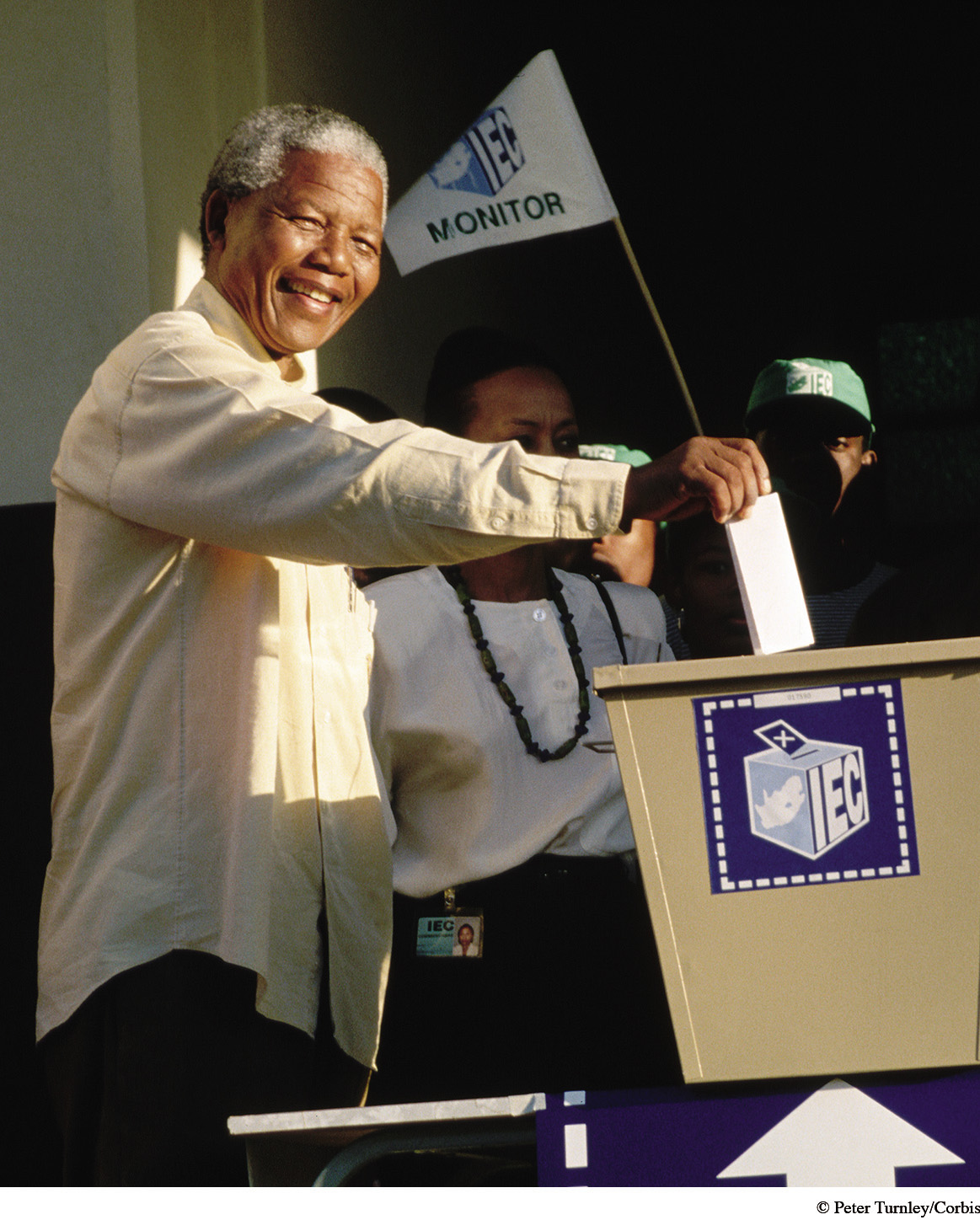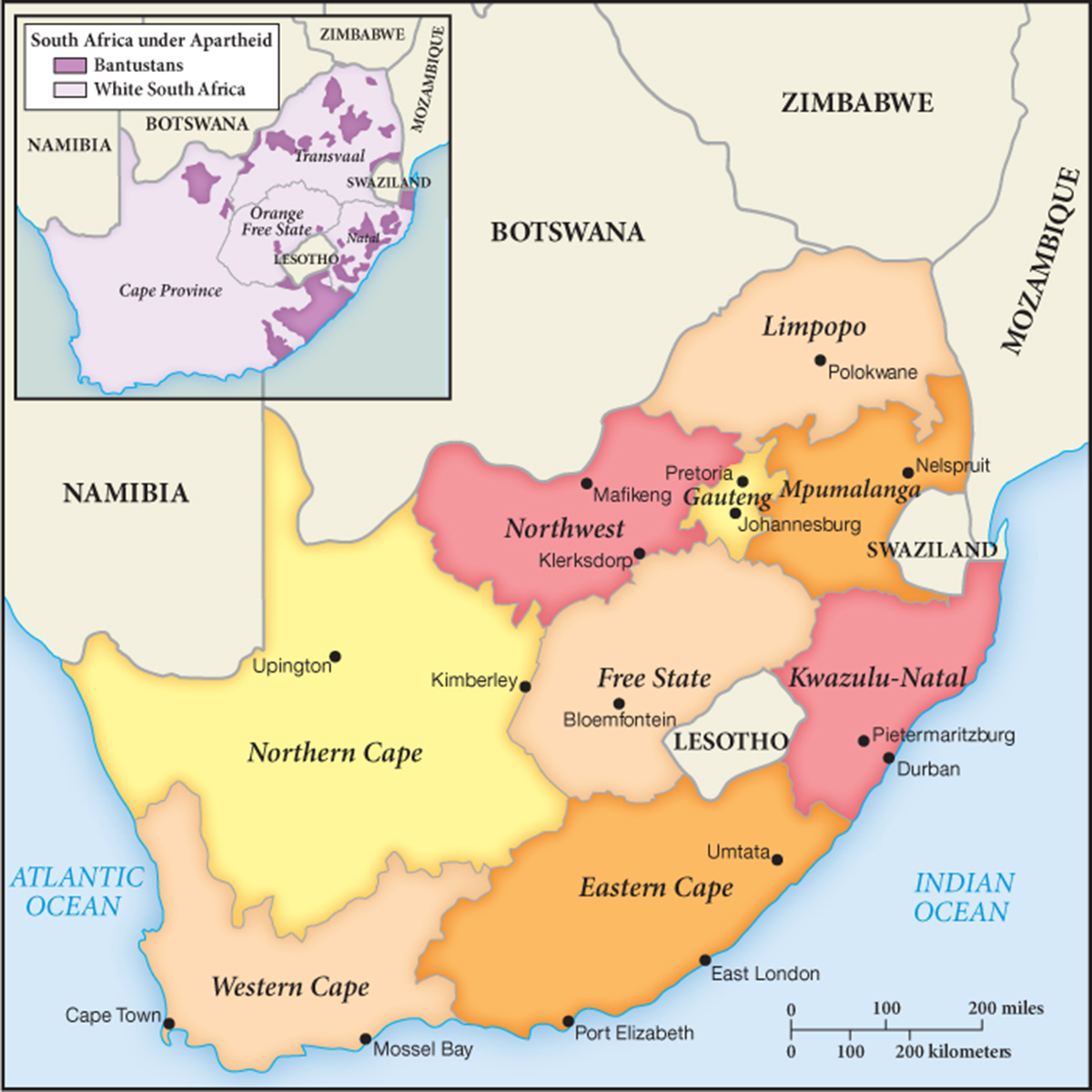The Case of South Africa: Ending Apartheid
The setting for South Africa’s freedom struggle was very different from that of India. In the twentieth century, that struggle was not waged against an occupying European colonial power, for South Africa had in fact been independent of Great Britain since 1910. Independence, however, had been granted to a government wholly controlled by a white settler minority, which represented less than 20 percent of the total population. The country’s black African majority had no political rights whatsoever within the central state. Black South Africans’ struggle therefore was against this internal opponent rather than against a distant colonial authority, as in India. Economically, the most prominent whites were of British descent. They or their forebears had come to South Africa during the nineteenth century, when Great Britain was the ruling colonial power. But the politically dominant section of the white community, known as Boers or Afrikaners, was descended from the early Dutch settlers, who had arrived in the mid-seventeenth century. The term “Afrikaner” reflected their image of themselves as “white Africans,” permanent residents of the continent rather than colonial intruders. They had unsuccessfully sought independence from a British-ruled South Africa in a bitter struggle (the Boer War, 1899–1902), and a sense of difference and antagonism lingered. Despite continuing hostility between white South Africans of British and Afrikaner background, both felt that their way of life and standard of living were jeopardized by any move toward black African majority rule. The intransigence of this sizable and threatened settler community helps explain why African rule was delayed until 1994, while India, lacking any such community, had achieved independence almost a half century earlier.
Why was African rule in South Africa delayed until 1994, when it had occurred decades earlier elsewhere in the colonial world?
Unlike a predominantly agrarian India, South Africa by the early twentieth century had developed a mature industrial economy, based initially in gold and diamond mining, but by midcentury including secondary industries such as steel, chemicals, automobile manufacturing, rubber processing, and heavy engineering. Particularly since the 1960s, the economy benefited from extensive foreign investment and loans. Almost all black Africans were involved in this complex modern economy, working in urban industries or mines, providing labor for white-owned farms, or receiving payments from relatives who did. The extreme dependence of most Africans on the white-controlled economy rendered individuals highly vulnerable to repressive action, but collectively the threat to withdraw their essential labor also gave them a powerful weapon.
A further unique feature of the South African situation was the overwhelming prominence of race, expressed since 1948 in the official policy of apartheid, which attempted to separate blacks from whites in every conceivable way while retaining Africans’ labor power in the white-controlled economy. An enormous apparatus of repression enforced that system. Rigid “pass laws” monitored and tried to control the movement of Africans into the cities, where they were subjected to extreme forms of social segregation. In the rural areas, a series of impoverished and overcrowded “native reserves,” or Bantustans, served as ethnic homelands that kept Africans divided along tribal lines. Even though racism was present in colonial India, nothing of this magnitude developed there.
As in India, various forms of opposition—resistance to conquest, rural rebellions, urban strikes, and independent churches—arose to contest the manifest injustices of South African life. There too an elite-led political party provided an organizational umbrella for many of the South African resistance efforts in the twentieth century. Established in 1912, the African National Congress (ANC), like its Indian predecessor, was led by male, educated, professional, and middle-class Africans who sought not to overthrow the existing order, but to be accepted as “civilized men” within it. They appealed to the liberal, humane, and Christian values that white society claimed. For four decades, its leaders pursued peaceful and moderate protest—petitions, multiracial conferences, delegations appealing to the authorities—even as racially based segregationist policies were implemented one after another.
How did South Africa’s struggle against white domination change over time?

Nelson Mandela In April 1994, the long struggle against apartheid and white domination in South Africa came to an end in the country’s first democratic and nonracial election. The symbol of that triumph was Nelson Mandela, long a political prisoner, head of the African National Congress, and the country’s first black African president. He is shown here voting in that historic election. (© Peter Turnley/Corbis)
Women were denied full membership in the ANC until 1943 and were restricted to providing catering and entertainment services for the men. But they took action in other arenas. In 1913, they organized a successful protest against carrying passes, an issue that endured through much of the twentieth century. Rural women in the 1920s used church-based networks to organize boycotts of local shops and schools. Women were likewise prominent in trade union protests, including wage demands for domestic servants and washerwomen. By 1948, when the Afrikaner-led National Party came to power on a platform of apartheid, it was clear that peaceful protest, whether organized by men or by women, had produced no meaningful movement toward racial equality.
During the 1950s, a new and younger generation of the ANC leadership, which now included Nelson Mandela, broadened its base of support and launched nonviolent civil disobedience—boycotts, strikes, demonstrations, and the burning of the hated passes that all Africans were required to carry. All of these actions were similar to and inspired by the tactics that Gandhi had pioneered in South Africa and used in India twenty to thirty years earlier. The government of South Africa responded with tremendous repression, including the shooting of sixty-nine unarmed demonstrators at Sharpville in 1960, the banning of the ANC, and the imprisonment of its leadership, including Nelson Mandela.
At this point, the freedom struggle in South Africa took a different direction than it had in India. Its major political parties were now illegal. Underground nationalist leaders turned to armed struggle, authorizing selected acts of sabotage and assassination, while preparing for guerrilla warfare in camps outside the country. Active opposition within South Africa was now primarily expressed by student groups that were part of the Black Consciousness movement, an effort to foster pride, unity, and political awareness among the country’s African majority, with a particular emphasis on mobilizing women for the struggle. Such young people were at the center of an explosion of protest in 1976 in a sprawling, segregated, impoverished black neighborhood called Soweto, outside Johannesburg, in which hundreds were killed. The initial trigger for the uprising was the government’s decision to enforce education for Africans in the hated language of the white Afrikaners rather than English. However, the momentum of the Soweto rebellion persisted, and by the mid-1980s spreading urban violence and the radicalization of urban young people had forced the government to declare a state of emergency. Furthermore, South Africa’s black labor movement, legalized only in 1979, became increasingly active and political. In June 1986, to commemorate the tenth anniversary of the Soweto uprising, the Congress of South African Trade Unions orchestrated a general strike involving some 2 million workers.
Beyond this growing internal pressure, South Africa faced mounting international demands to end apartheid as well. Exclusion from most international sporting events, including the Olympics; the refusal of many artists and entertainers to perform in South Africa; economic boycotts; the withdrawal of private investment funds—all of this isolated South Africa from a Western world in which its white rulers claimed membership. None of this had any parallel in India.
The combination of these internal and external pressures persuaded many white South Africans by the late 1980s that discussion with African nationalist leaders was the only alternative to a massive, bloody, and futile struggle to preserve white privileges. The outcome was the abandonment of key apartheid policies, the release of Nelson Mandela from prison, the legalization of the ANC, and a prolonged process of negotiations that in 1994 resulted in national elections, which brought the ANC to power. To the surprise of almost everyone, the long nightmare of South African apartheid came to an end without a racial bloodbath (see Map 22.3).

Map 22.3 South Africa after Apartheid Under apartheid, all black Africans were officially designated as residents of small, scattered, impoverished Bantustans, shown on the inset map. Many of these people, of course, actually lived in white South Africa, where they worked. The main map shows the new internal organization of the country as it emerged after 1994, with the Bantustans abolished and the country divided into nine provinces. Lesotho and Swaziland had been British protectorates during the colonial era and subsequently became separate independent countries, although surrounded by South African territory.
As in India, the South African nationalist movement was divided and conflicted. Unlike in India, though, these divisions did not occur along religious lines. Rather, it was race, ethnicity, and ideology that generated dissension and sometimes violence. Whereas the ANC generally favored a broad alliance of everyone opposed to apartheid (black Africans, Indians, “coloreds” or mixed-race people, and sympathetic whites), a smaller group known as the Pan Africanist Congress rejected cooperation with other racial groups and limited its membership to black Africans. During the urban uprisings of the 1970s and 1980s, young people supporting the Black Consciousness movements and those following Mandela and the ANC waged war against each other in the townships of South African cities. Perhaps most threatening to the unity of the nationalist struggle were the separatist tendencies of the Zulu-based Inkatha Freedom Party. Its leader, Gatsha Buthelezi, had cooperated with the apartheid state and even received funding from it. As negotiations for a transition to African rule unfolded in the early 1990s, considerable violence between Inkatha followers, mostly Zulu migrant workers, and ANC supporters broke out in a number of cities. None of this, however, approached the massive killing of Hindus and Muslims that accompanied the partition of India. South Africa, unlike India, acquired its political freedom as an intact and unified state.
SUMMING UP SO FAR
How and why did the anticolonial struggles in India and South Africa differ?

